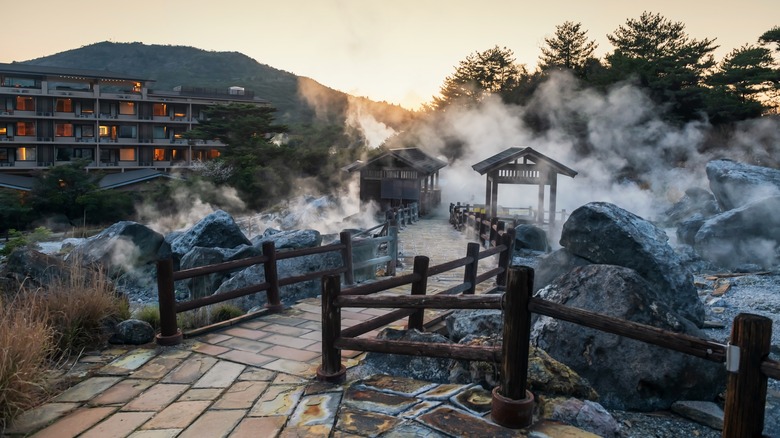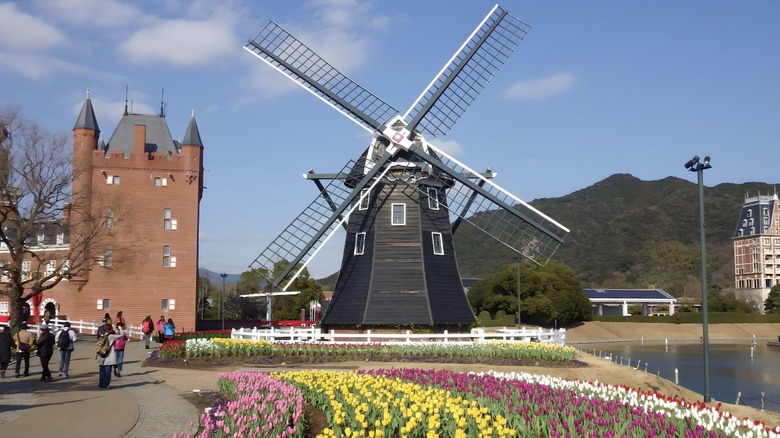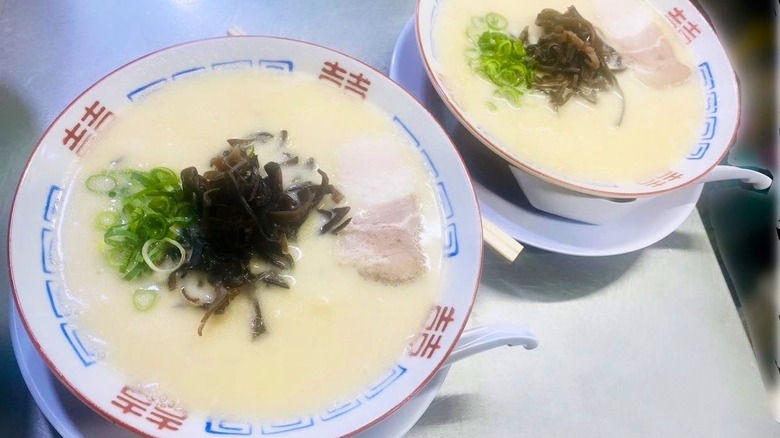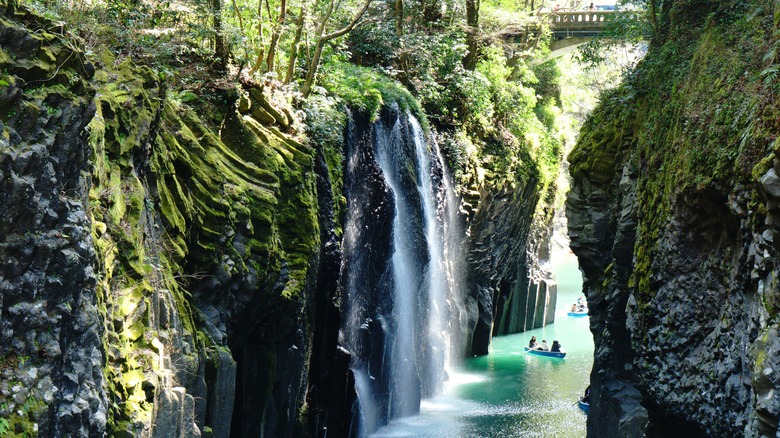Japan's Third Largest Island Is A Lesser-Known Haven Of Hot Springs And Exquisite Food
When tourists flock to Japan, they often gravitate toward its central island, Honshu, or its northern island, Hokkaido. This was the case in 2024, when Japan had three cities trending for travel among the top 10 worldwide: Tokyo and Osaka (located on Honshu) and Sapporo (located on Hokkaido). Among other things, Honshu also holds Mount Fuji, the Olympic ski destination of Nagano, and Japan's ancient capital, Kyoto, which has frequently appeared in magazine rankings of the world's best and most beautiful cities.
As worthwhile as a trip to these places can be, travelers looking to venture off the beaten path might want to head down south to Kyushu, the third-largest island in the Japanese archipelago. Otherwise, you'll be missing out on some good food, rich history, and amazing sights. While Kyushu itself might not have the same global name recognition as Tokyo, it's where you'll find places like Nagasaki, which survived the atomic bombing that ended World War II to become a beacon of international peace.
Today, Nagasaki is one of those cities in Japan that are just as fabulous as Tokyo. In its Chinatown district, you can snack on delicious kakuni manju (steamed pork buns) from Iwasaki Honpo. Overlooking the port, the five-story Chinese restaurant, Shikairou, is said to be where the creamy local dish of champon noodles was invented. One of Nagasaki's top tourist attractions is Gunkanjima, an abandoned coal-mining island that's shaped like a battleship. At the nearby resort town of Unzen Onsen, you can see a prime example of Kyushu's hot spring "hells" (jigoku), where steam clouds the volcanic landscape, as if to make human manju.
Exploring Kyushu, from Nagasaki to Fukuoka
Another interesting destination you can visit on a day trip in greater Nagasaki Prefecture is the Japanese theme park, Huis Ten Bosch. It recreates the Netherlands in painstaking detail, complete with windmills, tulips, and an observation tower where you might momentarily forget you're in Japan as you behold the sweeping view of Dutch architecture. This fake Netherlands isn't altogether random, as a Dutch trading post — situated on the artificial island of Dejima in Nagasaki — provided the only window to the West for over 200 years during Japan's isolationist period.
That window widened after World War II, when American hamburgers first caught on in Japan through the city of Sasebo, where Huis Ten Bosch is located. There are now over two dozen local shops specializing in the Sasebo Burger. Meanwhile, Dejima's previous inhabitants, the Portugese, introduced what would become Nagasaki's signature souvenir sweet, castella cake, into the country. You can get castella from the Nagasaki-based chains Fukusaya and Bunmeido, which have been in business since 1624 and 1900, respectively.
If you prefer Japanese street food to Nagasaki's Chinese, American, and Portugese imports, you'll find plenty of it in Kyushu's biggest city, Fukuoka. Here, you can dine on yakitori at a long row of riverside yatai (food stalls) on Nakasu Island. The Canal City Hakata mall, which does have a legitimate canal running through it, is a three-minute walk away. Enlivened by fountain shows, this is one of the sites where towering kazariyama floats are displayed every July during the Hakata Gion Yamakasa Festival. For top-notch, spicy, Hakata-style ramen with thin noodles, Genki Ippai has received recognition from the Michelin Guide.
Hakata ramen, the balloons of Saga, and Beppu Onsen
Genki Ippai now allows photography, but it used to have a list of rules for its ramen customers to follow, including no phone use. The idea was that you should give its tasty noodle bowls your full, undivided attention. Call it Zen and the art of ramen. A similar style of regimented ramen eating goes down at the popular Hakata-style chain, Ichiran, which has its original shop in Fukuoka. Some travelers say this bucket list ramen restaurant is overrated. However, it offers a unique fast-food experience where talking is discouraged as you sit on a stool at a partition booth, separated by dividers from other customers, with a bamboo curtain between you and the kitchen.
If you're traveling across Kyushu in late October or early November, you can see hundreds of hot-air balloons take to the skies at the Saga International Balloon Fiesta. Unlike its stateside counterpart in Albuquerque, New Mexico, this competitive event doesn't have balloon rides available. However, there's a hands-on hot-air balloon school you can participate in, and the Saga Balloon Challenge Series offers tethered rides on select Sunday mornings from late November to mid-February.
Kyushu's hot spring mecca is Beppu Onsen, a group of eight resorts in a city that holds the largest volume of hot spring water in Japan. At Hyoten Onsen, you can take a sand bath. At Myoban Onsen, you can bathe in milky or muddy water. Similar to Unzen, you'll also see seven hot spring "hells" in Beppu, where the various pools are boiling blue, blood-colored, or filled with mud bubbles or crocodiles.
Kumamoto Castle, Takachiho Gorge, and Kagoshima
Though an earthquake damaged it in 2016, Kumamoto Castle is still a magnificent sight. The 400-year-old castle complex won't see the full extent of its reconstruction completed until 2038, but it reopened its main keep in 2021, and in the springtime, it's still a fabulous spot for cherry blossom viewing in Japan. In Kumamoto Prefecture, you can also visit Kurokawa Onsen for more hot springs action, or you can take a helicopter ride for a bird's-eye view of Mount Aso, the country's biggest active volcano. Keep your eyes peeled for Kumamon, the prefecture's black bear ambassador, who has become one of the most well-known local mascots in Japan.
Perhaps the most scenic natural spot in Kyushu is Takachiho Gorge. Formed by Aso's lava flow, this narrow gorge has a river running through it, where you can rent a boat and paddle alongside waterfalls and cliffs that shoot straight up. It almost feels like something out of "The Lord of the Rings," and the texture of the volcanic rock columns has even been likened to dragon scales.
Another active volcano in Kyushu is Sakurajima, which forms a majestic sight across the bay from Kagoshima. Take a ferry to the volcano island and you can view its periodic eruptions at a relatively safe distance from the observation points encircling it. Kagoshima is the kind of place where you might need an umbrella: not only for rain in typhoon season, but for ash clouds. Ferries also provide access to Yakushima, which inspired the Hayao Miyazaki film, "Princess Mononoke," and which is one of Japan's best national parks for hikers seeking a challenge.



